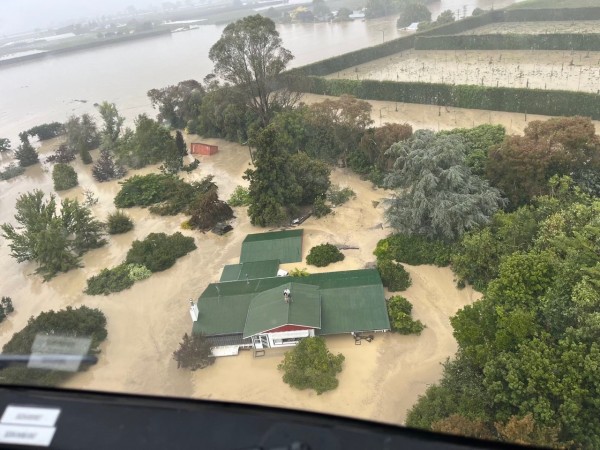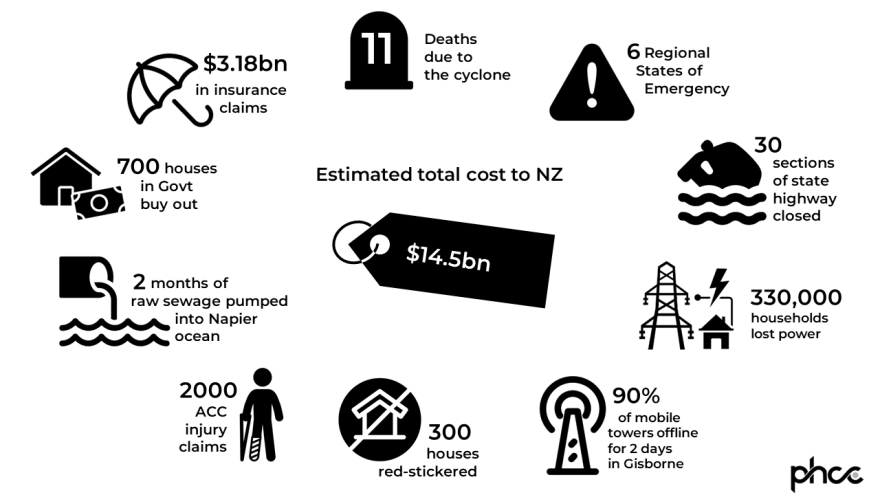References
- Kerr J, Thomson G, Wilson N. Cyclone Gabrielle joins list of Aotearoa NZ’s ‘sudden mass fatality events’. Public Health Expert Briefing (28 March). https://ourarchive.otago.ac.nz/bitstream/handle/10523/15138/Cyclone%20Gabrielle%20joins%20list%20of%20Aotearoa%20NZ%E2%80%99s%20%E2%80%98sudden%20mass%20fatality%20events%E2%80%99%20_%20PHCC.pdf?sequence=1. 2023
- Wilson N, Broadbent A, Kerr J. Cyclone Gabrielle by the numbers – A review at six months. Public Health Expert Briefing 2023;(14 August). https://www.phcc.org.nz/briefing/cyclone-gabrielle-numbers-review-six-months.
- Wilson N, Payne B, Kerr J, et al. Embracing downward counterfactual analysis to navigate future cyclones. Public Health Expert Briefing 2023;(7 June). https://www.phcc.org.nz/briefing/embracing-downward-counterfactual-analysis-navigate-future-cyclones.
- Radio NZ. Cyclone Gabrielle: First two homeowners accept buyout offers. Radio NZ 2023;(19 December). https://www.rnz.co.nz/news/national/505114/cyclone-gabrielle-first-two-homeowners-accept-buyout-offers.
- SIL Research/Napier City Council. Napier City Council 2023 Post-Cyclone Community Wellbeing Survey | SIL Research. 2023;(July). https://www.napier.govt.nz/assets/Uploads/2023-FINAL-NCC-Post-Cyclone-Community-Wellbeing-Survey-report.pdf.
- Hyde S. Cyclone Gabrielle’s Long Tail: Mental Distress. Bay Buzz 2023;(10 November). https://baybuzz.co.nz/cyclone-gabrielles-long-tail-mental-distress/.
- Ellingham J. Wairoa waiting for recovery help 10 months after Cyclone Gabrielle. Hawkes Bay Today (from Radio NZ). 2023;(28 December). https://www.nzherald.co.nz/hawkes-bay-today/news/treated-like-the-poor-cousin-waiting-10-months-after-cyclone-gabrielle/HGYJZ6D4H5FN3LYT2BLFHS3HIA/.
- Smith W, Davies‐Colley C, Mackay A, et al. Social impact of the 2004 Manawatu floods and the ‘hollowing out’of rural New Zealand. Disasters 2011;35(3):540-53.
- Teng AM, Blakely T, Ivory V, et al. Living in areas with different levels of earthquake damage and association with risk of cardiovascular disease: a cohort-linkage study. The Lancet Planetary Health 2017;1(6):e242-e53.
- Radio NZ. Weddings, warm weather and water parks: Tourists return to Hawke's Bay in droves. Radio NZ 2024;(15 January). https://www.rnz.co.nz/news/national/506740/weddings-warm-weather-and-water-parks-tourists-return-to-hawke-s-bay-in-droves.
- Pocock J. Christopher Luxon puts brakes on Napier-Wairoa rail during Hawke’s Bay visit. NZ Herald 2023;(8 December). https://www.nzherald.co.nz/hawkes-bay-today/news/christopher-luxon-puts-brakes-on-napier-wairoa-rail-during-hawkes-bay-visit/2FDU7SG7H5C5VOI7SZC4I5OCJ4/.
- Ellingham J. East Coast and Tairāwhiti farmers still struggling 10 months after Cyclone Gabrielle. Radio NZ 2023;(21 December). https://www.rnz.co.nz/news/country/505316/east-coast-and-tairawhiti-farmers-still-struggling-10-months-after-cyclone-gabrielle.
- Radio NZ. One hundred tourist sites closed this summer due to Cyclone Gabrielle damage. Radio NZ 2023;(16 December). https://www.rnz.co.nz/news/national/504897/one-hundred-tourist-sites-closed-this-summer-due-to-cyclone-gabrielle-damage.
- Xia L. Almost a year since floods, Auckland parks and reserves still waiting for fixes. Radio NZ 2024;(4 January). https://www.rnz.co.nz/news/national/505998/almost-a-year-since-floods-auckland-parks-and-reserves-still-waiting-for-fixes.
- Wilson N, Chambers T, Prickett M, et al. Water infrastructure failures from Cyclone Gabrielle show low resilience to climate change. Public Health Expert Briefing 2023;(25 May). https://www.phcc.org.nz/briefing/water-infrastructure-failures-cyclone-gabrielle-show-low-resilience-climate-change.
- Radio NZ. Cyclone-damaged roads and highways breaking up just weeks after being repaired. Radio NZ 2023;(20 December). https://www.rnz.co.nz/news/national/505191/cyclone-damaged-roads-and-highways-breaking-up-just-weeks-after-being-repaired.
- Wong J. $200,000 temporary Gisborne causeway washed away, 25 days after it opens. Stuff 2023;(14 June). https://www.stuff.co.nz/national/132295336/200000-temporary-gisborne-causeway-washed-away-25-days-after-it-opens.
- Coughlan T. Treasury warns New Zealand has massive infrastructure gap, expected to get bigger in future. NZ Herald 2022;(22 March). https://www.nzherald.co.nz/nz/politics/treasury-warns-new-zealand-has-massive-infrastructure-gap-expected-to-get-bigger-in-future/HWYI2OPRMP4V4LDCQEXPZ7Y2AQ/.
- Radio NZ. Timeline: The troubled Cook Strait ferries. Radio NZ 2023;(13 November). https://www.rnz.co.nz/news/national/502312/timeline-the-troubled-cook-strait-ferries
- Molyneux V. Multi-billion-dollar bill to fix Wellington’s ageing water network. NZ Herald 2023;(6 November). https://www.nzherald.co.nz/nz/multi-billion-dollar-bill-to-fix-wellingtons-ageing-water-network/NDXVQNFDBNFGPKDIE2ZI6FJHYY/
- Radio NZ. Cyclone Gabrielle: Probe of Civil Defence reaction attracts 1000 responses so far. Radio NZ 2024;(8 January). https://www.rnz.co.nz/news/national/506262/cyclone-gabrielle-probe-of-civil-defence-reaction-attracts-1000-responses-so-far.
- Boston J. Funding Managed Retreat: Designing a Public Compensation Scheme for Private Property Losses: Policy Issues and Options (Report Prepared for the Environmental Defence Society). February 2023. https://eds.org.nz/wp-content/uploads/2022/11/Jonathan-Boston-Funding-Managed-Retreat-Final.pdf.
About the Briefing
Public health expert commentary and analysis on the challenges facing Aotearoa New Zealand and evidence-based solutions.
Subscribe

Public Health Expert Briefing
Get the latest insights from the public health research community delivered straight to your inbox for free. Subscribe to stay up to date with the latest research, analysis and commentary from the Public Health Expert Briefing.

